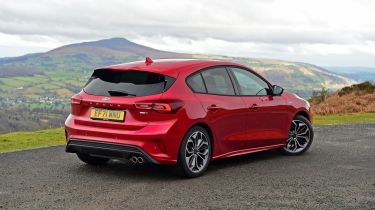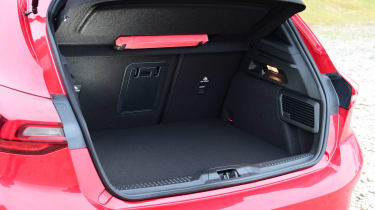Ford Focus review - Practicality & boot space
"The latest Ford Focus has plenty of interior space and its boot is competitive with rivals"
One area in which the third-generation Focus came up a little short was rear-seat space – it was adequate, but rivals had more room. Fortunately, Ford rethought the Focus' layout for its fourth generation, pushing the windscreen forward to allow a longer interior. The extra space liberated is mostly devoted to passenger accommodation, so some rivals are still more capable in the boot space department.
Those in the front enjoy plenty of room, with multi-adjustable seats and a steering wheel that adjusts for height and reach. There's less clutter between the driver and passenger than in previous Focus models, particularly the diesel models with the 8-speed automatic gearbox, which now has a rotary selector that takes up less space than the previous gear lever. The 7-speed Powershift gearbox still has a conventional stick shifter. The centre console has soft areas where knees are likely to make contact, too.
In the back there's far more room for knees and shoulders and the floor is flat with space under the front seats, too – this means that centre rear-seat occupants no longer have to splay their legs uncomfortably to find somewhere for their feet. The Focus now leads the Volkswagen Golf and Vauxhall Astra for rear seat space, and if you ever need to carry a fifth passenger, it has the softest and most usable middle seat as well.
More reviews
Parents of young children will also be happy to hear the Focus is one of the best in its class for installing a child seat. It has large rear doors for a start, and its ISOFIX mounting points are also very easy to access behind removable plastic covers.
|
Size comparison | |||
|
Model |
Length |
Width |
Height |
|
Ford Focus hatchback |
4,382mm |
1,825mm |
1471mm |
|
Ford Focus estate |
4,668mm |
1,825mm |
1,485mm |
|
Volkswagen Golf hatchback |
4,284mm |
1,789mm |
1,491mm |
|
Volkswagen Golf estate |
4,633mm |
1,789mm |
1,455mm |
|
Peugeot 308 hatchback |
4,367mm |
1,852mm |
1,441mm |
Boot space
Ford Focus boot space is competitive with family hatchback rivals. With the rear seats in use, it offers 375 litres of luggage room – only five litres behind the Volkswagen Golf and almost 60 more than the previous Focus. If maximum carrying capacity is a must, though, the 590-litre Skoda Octavia still has a considerable advantage. Folding the rear seats down frees up a total of 1,354 litres – a little more than the Golf can offer.
The Focus doesn’t have an adjustable floor level like the Golf or Astra, but it does get some handy features such as bag hooks and a ski hatch for through loading long items without losing use of the outer rear seats. All the Focus Estate models get a clever boot divider system with space to store the parcel shelf under the boot floor.
|
Boot space comparison | |
|
Model |
Boot space |
|
Ford Focus hatchback |
375 litres |
|
Ford Focus estate |
575 litres |
|
Volkswagen Golf hatchback |
381 litres |
|
Volkswagen Golf estate |
611 litres |
|
Peugeot 308 hatchback |
412 litres |
Towing
There are towing attachments on the Ford Focus options list with either a full trailer coupling or the electrical wiring to attach an aftermarket towbar available. The full towing attachment includes Trailer Stability assist and the Blind Spot Monitoring system can be adjusted to account for the length of whatever it is you’re towing.
Towing weights differ according to the model but the capacities range between 1,100kg braked trailer in the 1.0-litre Ecoboost up to 1,600kg in the 2.3-litre ST. The Ecoblue diesel can tow 1,400kg.
Which Is Best?
Cheapest
- Name1.0 EcoBoost Hybrid mHEV ST-Line 5dr
- Gearbox typeManual
- RRP£29,330
Most Economical
- Name1.0 EcoBoost Hybrid mHEV ST-Line 5dr
- Gearbox typeManual
- RRP£29,330
Fastest
- Name1.0 EcoBoost Hybrid mHEV 155 ST-Line 5dr Auto
- Gearbox typeAuto
- RRP£31,180










